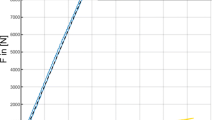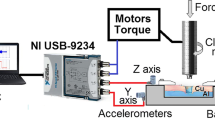Abstract
An online detection technology must be developed for realizing the real-time control of friction stir welding. In this study, the three-dimensional force exerted on a material during friction stir welding was collected synchronously and the relationship between the forces and welding quality was investigated. The results indicated that the fluctuation period of the traverse force was equal to that of the lateral force during the stable welding stage. The phase difference between two horizontal forces was π/2. The values of the horizontal forces increased with welding speed, whereas their amplitudes remained the same. The proposed force model showed that the traverse and lateral forces conformed to an elliptical curve, and this result was consistent with the behavior of the measured data. The variational mode decomposition was used to process the plunge force. The intrinsic mode function that represented the real fluctuation in the plunge force varied at the same frequency as the spindle rotational speed. When tunnel defects occurred, the fluctuation period features were consistent with those obtained during normal welding, whereas the ratio parameter defined in this study increased significantly.















Similar content being viewed by others
References
Huang Y, Yuan Y, Yang L et al (2020) Real-time monitoring and control of porosity defects during arc welding of aluminum alloys. J Mater Process Technol 286:116832. https://doi.org/10.1016/j.jmatprotec.2020.116832
Huang Y, Wu D, Zhang Z et al (2017) EMD-based pulsed TIG welding process porosity defect detection and defect diagnosis using GA-SVM. J Mater Process Technol 239:92–102
Wang G, Zhao Y, Hao Y (2018) Friction stir welding of high-strength aerospace aluminum alloy and application in rocket tank manufacturing. J Mater Sci Technol 34:73–91
Rajendran C, Srinivasan K, Balasubramanian V et al (2019) Effect of tool tilt angle on strength and microstructural characteristics of friction stir welded lap joints of AA2014-T6 aluminum alloy. Trans Nonferrous Met Soc China 29(9):1824–1835
Ambrosio D, Dessein G, Wagner V et al (2022) On the potential applications of acoustic emission in friction stir welding. J Manuf Process 75:461–475
Mishra D, Roy RB, Dutta S et al (2018) A review on sensor based monitoring and control of friction stir welding process and a roadmap to Industry 4.0. J Manuf Process 36:373–397
Chen S, Li H, Lu S et al (2015) Temperature measurement and control of bobbin tool friction stir welding. Int J Adv Manuf Technol 86:337–346
Chen C, Kovacevic R, Jandgric D (2003) Wavelet transform analysis of acoustic emission in monitoring friction stir welding of 6061 aluminum. Int J Mach Tools Manuf 43:1383–1390
Soundararajan V, Valant M, Kovacevic R et al (2018) An overview of R&D work in friction stir welding at SMU. Metall Mater Eng 12(4):516–520
Franke D, Rudraraju S, Zinn M et al (2020) Understanding process force transients with application towards defect detection during friction stir welding of aluminum alloys. J Manuf Process 54:251–261
Sahu SK, Mishra D, Pal K et al (2020) Multi sensor based strategies for accurate prediction of friction stir welding of polycarbonate sheets. Proc Inst Mech Eng Part C J Mech Eng Sci 235:3252–3272
Roy RB, Ghosh A, Bhattacharyya S et al (2018) Weld defect identification in friction stir welding through optimized wavelet transformation of signals and validation through X-ray micro-CT scan. Int J Adv Manuf Technol 99:623–633
Mishra D, Gupta A, Raj P et al (2020) Real time monitoring and control of friction stir welding process using multiple sensors. CIRP J Manuf Sci Technol 30:1–11
Trimble D, Monaghan J, O’Donnell GE (2012) Force generation during friction stir welding of AA2024-T3. CIRP Annals 61:9–12
Banik A, Deb Barma J, Saha SC (2019) Effect of threaded pin tool for friction stir welding of AA6061-T6 at varying traverse speeds: torque and force analysis. Iran J Sci Technol Trans Mech Eng 44:749–764
Guan W, Li D, Cui L et al (2021) Detection of tunnel defects in friction stir welded aluminum alloy joints based on the in-situ force signal. J Manuf Process 71:1–11
Dong J, Huang Y, Zhu J et al (2023) Variation mechanism of three-dimensional force and force-based defect detection in friction stir welding of aluminum alloys. Materials 16:1312. https://doi.org/10.3390/ma16031312
Dragomiretskiy K, Zosso D (2013) Variational mode decomposition. IEEE Trans Signal Process 62:531–544
Huang Y, Hou S, Xu S et al (2019) EMD-PNN based welding defects detection using laser-induced plasma electrical signals. J Manuf Process 45:642–651
Heidarzadeh A, Mironov S, Kaibyshev R et al (2021) Friction stir welding/processing of metals and alloys: a comprehensive review on microstructural evolution. Prog Mater Sci 117:100752. https://doi.org/10.1016/j.pmatsci.2020.100752
Meng X, Huang Y, Cao J et al (2021) Recent progress on control strategies for inherent issues in friction stir welding. Prog Mater Sci 115:100706. https://doi.org/10.1016/j.pmatsci.2020.100706
Nandan R, DebRoy T, Bhadeshia H (2008) Recent advances in friction-stir welding-process, weldment structure and properties. Prog Mater Sci 53:980–1023
Acknowledgements
This work was supported by the National Natural Science Foundation of China (Grant No. 52201048), the China Postdoctoral Science Foundation (Grant No. 2020M670651), and the National Natural Science Foundation of China (Grant No. 52075376).
Author information
Authors and Affiliations
Corresponding authors
Rights and permissions
Springer Nature or its licensor (e.g. a society or other partner) holds exclusive rights to this article under a publishing agreement with the author(s) or other rightsholder(s); author self-archiving of the accepted manuscript version of this article is solely governed by the terms of such publishing agreement and applicable law.
About this article
Cite this article
Dong, JH., Huang, YM., Zhu, JL. et al. Quality assessment of friction-stir-welded aluminum alloy welds via three-dimensional force signals. Adv. Manuf. 12, 61–75 (2024). https://doi.org/10.1007/s40436-023-00452-2
Received:
Revised:
Accepted:
Published:
Issue Date:
DOI: https://doi.org/10.1007/s40436-023-00452-2




